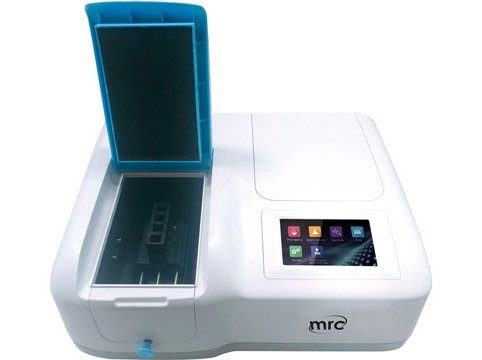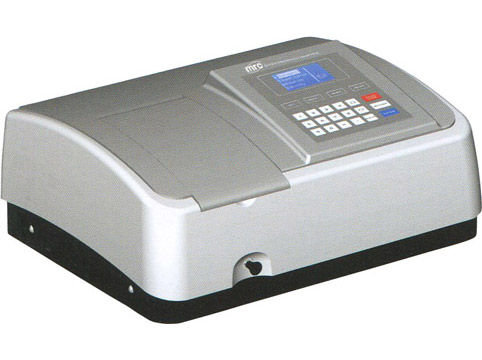The complete guide to spectrophotometers by MRC
How is a UV-Vis spectrophotometer different from other types of spectrophotometers?
A UV-Vis (Ultraviolet-Visible) spectrophotometer measures the absorption or transmission of light in the ultraviolet (UV) and visible (Vis) regions of the electromagnetic spectrum. It operates by passing a beam of light through a sample and measuring how much light is absorbed by the sample at various wavelengths. The main difference between a UV-Vis spectrophotometer and other types of spectrophotometers lies in the specific range of wavelengths they measure and the applications they are suited for.
Here are some key differences between a UV-Vis spectrophotometer and other types of spectrophotometers:
- Wavelength Range:
- UV-Vis Spectrophotometer: This type covers the range from about 190 nm (nanometers) to 800 nm, encompassing both the ultraviolet and visible regions of the electromagnetic spectrum.
- Infrared (IR) Spectrophotometer: measure light in the infrared region of the spectrum, typically ranging from about 800 nm to 15,000 nm. IR spectroscopy is used to study molecular vibrations and identify functional groups in organic compounds.
- X-ray Spectrophotometer: measure X-rays, which have much shorter wavelengths than UV and visible light. They are used to study crystal structures and material properties.
- Applications:
- UV-Vis Spectrophotometer: Used to quantify the concentration of a substance in a solution, determine the absorbance and transmittance properties of molecules, and study electronic transitions in molecules. It finds applications in fields like chemistry, biochemistry, environmental science, and material science.
- IR Spectrophotometer: Used to study molecular vibrations, analyze functional groups, identify unknown compounds, and study molecular structures. It's widely used in organic and inorganic chemistry, biochemistry, and materials science.
- X-ray Spectrophotometer: Used for studying crystal structures, crystallography, and material characterization in fields such as solid-state physics, chemistry, and materials science.
- Sample Types:
- UV-Vis Spectrophotometer: Used for solutions of molecules and compounds in liquid form, as well as solid samples with appropriate preparation.
- IR Spectrophotometer: IR spectroscopy can be applied to liquids, solids, and gases. It's particularly useful for studying functional groups in organic molecules.
- X-ray Spectrophotometer: Used for crystalline materials, such as minerals, metals, and organic crystals.

What are the components of spectrophotometers?
A spectrophotometer is an instrument used to measure the intensity of light at different wavelengths, allowing for the analysis of the absorption, transmission, and reflection of light by various materials. The key components:
Light Source: This provides a controlled and stable light beam that is directed through the sample. Common light sources include tungsten-halogen lamps, deuterium lamps (for the ultraviolet range), and light-emitting diodes (LEDs).
Monochromator: The monochromator is responsible for selecting a specific wavelength of light from the source. It does this by using a diffraction grating or prism to disperse the light into its component wavelengths and then selecting a single wavelength to pass through to the sample.
Sample Compartment: This is where the sample is placed for analysis. It may be in the form of a cuvette (a small, transparent container) for liquid samples or a holder for solid samples. The sample compartment should ensure that the light passes through the sample in a consistent and controlled manner.
Detector: The detector measures the intensity of light that passes through the sample at the selected wavelength. Common types of detectors include photodiodes, photomultiplier tubes (PMTs), and charge-coupled devices (CCDs).
Signal Processor: The signal processor amplifies and converts the analog signal from the detector into a digital signal that can be further processed by the instrument's electronics.
Display/Output: The results of the analysis are displayed on a screen, often showing a graph of absorbance or transmittance vs. wavelength. Some may also provide options to export the data for further analysis.
Wavelength Selector: This component allows the user to set the desired wavelength for measurement. It can be adjusted manually or through software control.
Calibration Controls: Spectrophotometers need to be calibrated regularly using standard samples of known properties to ensure accurate and consistent measurements.
Electronic Control System: The electronic control system manages the various components, including controlling the light source, monochromator, detector, and data processing.
Power Supply: A stable power supply is necessary to ensure the accuracy and reliability of the measurements.

concept of absorbance and transmittance in relation to spectrophotometry
Absorbance: Absorbance, also known as optical density, is a measure of how much light is absorbed by a sample at a specific wavelength. When light passes through a sample, some of the photons (light particles) are absorbed by the molecules in the sample. The absorbance of a substance is directly proportional to the concentration of the absorbing species and the path length of the light through the sample. Mathematically, absorbance (A) is often expressed using the Beer-Lambert Law:
�=−log10(�)A=−log10(T)
Where:
- �A is the absorbance
- �T is the transmittance
Absorbance values can range from 0 (no absorption) to infinity (complete absorption). A higher absorbance indicates that more light has been absorbed by the sample.
Transmittance: Transmittance is a measure of the amount of light that passes through a sample relative to the amount of light that enters it. It is expressed as a fraction or a percentage. Transmittance is related to absorbance through the equation:
�=10−�T=10−A
Where:
- �T is the transmittance
- �A is the absorbance
Transmittance values range from 0 (no light transmitted) to 1 (all light transmitted). A higher transmittance indicates that less light has been absorbed by the sample.
How a double-beam spectrophotometer works
A double-beam spectrophotometer is a scientific instrument used to measure the absorption or transmission of light by a sample in order to determine its concentration, composition, or other optical properties. It operates based on the principles of absorption spectroscopy, which involves analyzing how a sample absorbs light at various wavelengths.
Here's how a double-beam spectrophotometer works:
- Light Source: The instrument consists of a light source that emits a broad spectrum of light, usually including visible and ultraviolet (UV) regions. Common light sources include tungsten-halogen lamps or deuterium lamps for UV regions.
- Monochromator: The emitted light passes through a monochromator, which is an optical component that separates the incoming light into its various wavelengths. This is achieved through the use of diffraction gratings or prisms. The monochromator allows the user to select a specific wavelength of light to pass through the sample.
- Sample Compartment: The selected wavelength of light then enters the sample compartment, where the sample to be analyzed is placed. The sample can be in various forms, such as a liquid, solid, or gas, depending on the application.
- Reference Beam: In a double-beam, a reference beam of light is simultaneously directed to a reference cell containing a known, optically transparent substance that doesn't absorb light at the chosen wavelength. This provides a baseline measurement of the incident light intensity before it interacts with the sample.
- Sample Beam: The main beam of light passes through the sample, where it interacts with the molecules present in the sample. Some of the light is absorbed by the sample, depending on its composition and concentration.
- Detector: After passing through the sample, the transmitted light is directed to a detector. The detector measures the intensity of the transmitted light, converting it into an electrical signal.
- Data Analysis: The spectrophotometer then compares the intensity of the transmitted light from the sample (sample beam) to that of the reference cell (reference beam). The difference in intensities between the two beams indicates the amount of light absorbed by the sample. This information is used to calculate the absorbance of the sample at the selected wavelength.
- Calculation: Absorbance (A) is defined as the logarithm of the ratio of the incident light intensity (I₀) to the transmitted light intensity (I):
A = -log₁₀(I/I₀)
- Quantitative Analysis: The absorbance is directly proportional to the concentration of the absorbing substance in the sample, according to the Beer-Lambert Law. This law states that the absorbance is equal to the molar absorptivity (ε), the path length (b), and the concentration (c) of the sample:
A = ε * b * c
By measuring the absorbance at different wavelengths, a spectrum of the sample's absorption behavior can be obtained. This information can then be used to identify substances and determine their concentrations in the sample.
How to choose spectrophotometers
Choosing a spectrophotometer involves considering several factors to ensure that you select the right instrument for your specific needs. They are used to measure the absorption or transmission of light by a sample across different wavelengths. Here's a step-by-step guide to help you choose:
Application and Sample Type:
Identify the primary purpose. Are you measuring the concentration of a specific substance, analyzing the purity of a sample, or studying the characteristics of a material? Different applications might require specific features and wavelength ranges.
Wavelength Range:
Consider the wavelength range needed for your application. Some of them cover a wide range, while others are specialized for specific regions like ultraviolet (UV), visible (VIS), or infrared (IR). Choose a wavelength range that aligns with your analysis needs.
Resolution and Accuracy:
Check the resolution and accuracy. Higher resolution allows you to distinguish smaller differences in absorbance values. Accuracy is crucial for obtaining reliable and precise results.
Sample Compatibility:
Ensure that the spectrophotometer is compatible with the type of samples you'll be working with. Some samples might require specific cuvettes, accessories, or handling methods.
Sample Size and Format:
Consider the size and format of your samples. Some of them can accommodate different cuvette sizes or offer options for solid samples, microplates, or even direct measurements.
Throughput and Speed:
If you need to process a high number of samples quickly, consider the throughput and speed of the instrument. Some are optimized for rapid analysis.
Software and Data Handling:
Evaluate the software provided with the spectrophotometer. User-friendly software can simplify data collection, analysis, and reporting. Look for compatibility with your data management systems.
Light Source:
Different spectrophotometers use various light sources, such as tungsten lamps, deuterium lamps, or light-emitting diodes (LEDs). Choose a source that suits your application's wavelength range and stability requirements.
Calibration and Maintenance:
Check the ease of calibration and maintenance. Regular calibration is essential for accurate measurements. Look for instruments with straightforward calibration procedures.